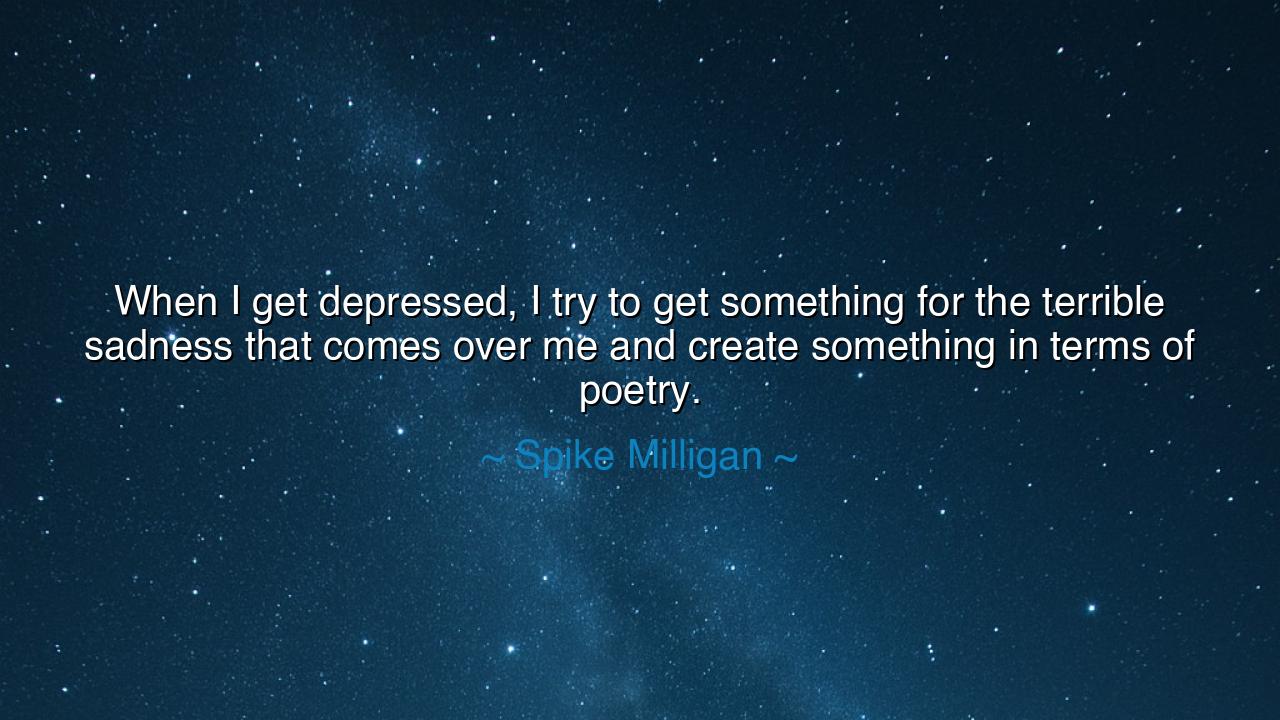
When I get depressed, I try to get something for the terrible
When I get depressed, I try to get something for the terrible sadness that comes over me and create something in terms of poetry.






The words of Spike Milligan strike the heart like a lament carried on the wind: “When I get depressed, I try to get something for the terrible sadness that comes over me and create something in terms of poetry.” In this confession, he reveals the ancient alchemy of suffering transformed into beauty. For when the spirit is weighed down by darkness, one may either be consumed by it or transmute it into light. Milligan chose the latter: he turned grief into poetry, pain into creation, despair into a vessel for meaning.
The ancients knew this path well. The poet Sappho, when torn by longing and exile, did not bury her sorrow in silence but carved it into lines that still tremble across the centuries. The psalmists of Israel, in their sadness, cried out to the heavens with songs that mingled grief with hope. Milligan’s words echo this timeless tradition: the practice of giving form to sorrow, shaping it into something that not only saves the self but also speaks to the hearts of others.
What is profound in Milligan’s words is the honesty of the struggle. He does not deny the weight of depression, nor does he speak as though one can simply dismiss it. He acknowledges the “terrible sadness” as a force that descends, uninvited and overwhelming. Yet he also reveals the hidden weapon: creativity. Poetry becomes both shield and sword, a way of channeling sorrow rather than being drowned by it. It is not the absence of pain, but the transformation of pain into expression, that gives relief.
Consider the life of Vincent van Gogh. He lived in storms of inner torment, plagued by despair and isolation. Yet rather than surrender wholly to his darkness, he painted with a ferocity that turned anguish into brilliance. His “Starry Night” is not merely an image of the heavens, but a cry of the soul longing for peace. Like Milligan, van Gogh shows us that art born of sorrow is not weakness—it is testimony, the ability to make one’s suffering speak.
And so Milligan’s words become both comfort and command. Comfort, because they remind us we are not alone in our struggles; even great artists have walked through shadows. Command, because they remind us not to waste our pain in silence, but to forge it into creation. Poetry, music, painting, or any form of expression becomes a bridge between despair and hope, a way to give meaning to what feels unbearable.
The lesson is this: when sorrow comes, do not bury it like a corpse, for it will rot within you. Bring it into the light. Shape it, sing it, write it. In doing so, you not only unburden your own soul, but you leave behind a gift for others who will one day find healing in your words. For what is born of true suffering often carries the deepest power to touch the human heart.
Practical actions follow: when you feel the weight of sadness, take up a pen and let your thoughts spill into verse. When the heart aches, turn to music or painting, allowing creation to absorb the heaviness. Share your work if you are able, for in sharing, the burden grows lighter. And above all, remember Milligan’s wisdom—that depression may descend, but within it lies the seed of poetry, waiting to be born.






MLMai Lan
I appreciate how Spike Milligan uses poetry as a way to process his sadness. It reminds me that art can serve as a bridge between our emotional experiences and how we express them. But I wonder, can this approach work for everyone, or do some people find it harder to use creativity as a tool for healing? How do we encourage others who may not feel inspired to create when they’re experiencing sadness?
BPDo Ba Bao Phuc
Spike Milligan’s approach to depression through poetry is intriguing. It suggests that creating something meaningful out of pain can help bring a sense of purpose to sadness. But can this method work for everyone? Is it possible to rely on creative outlets to manage depression, or should they be combined with other strategies like therapy or medication? What role do you think art plays in mental health recovery?
NHTran Dinh Ngoc Han
I find it powerful how Spike Milligan channels his depression into poetry. It makes me think—can creative outlets help us confront our feelings more directly, or do they sometimes mask them? How do we ensure that we’re using creativity in a healthy way that truly helps, rather than just distracting from our emotions? Is it possible that, through art, we can better understand and express the sadness we experience?
BNDao Bich Ngan
Spike Milligan’s quote resonates with me because it speaks to how creativity can be a form of emotional release. It’s almost like he transforms his depression into something tangible, like poetry. I wonder, how often do we overlook the therapeutic power of creative expression? Can creativity really help us cope with deep sadness, or do we need other outlets, too? What do you think is the relationship between mental health and creative work?